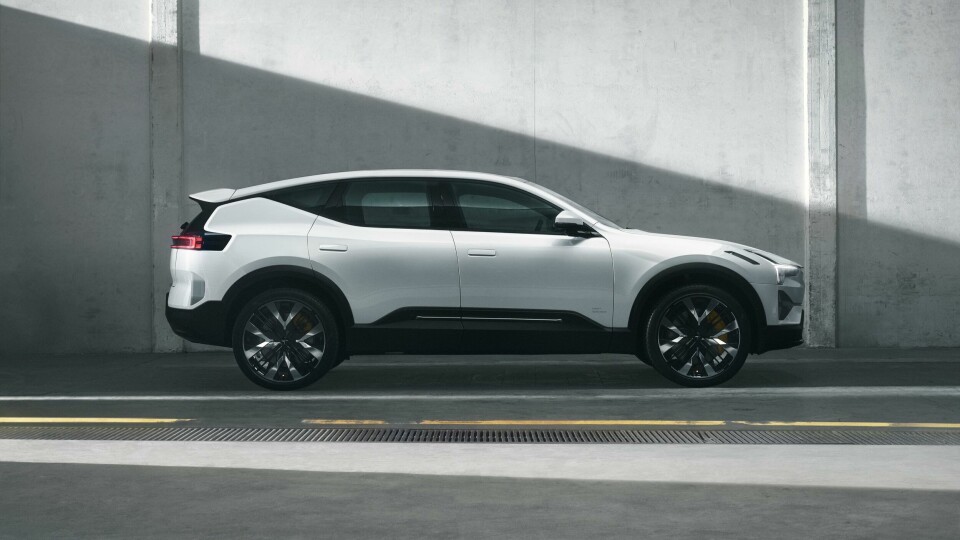
The Polestar 3 breaks cover in Copenhagen
Polestar debuted its full-sized SUV to media, dealers, and customers at a special event in Copenhagen, showing off a crucial model for the brand as it inches closer to a full lineup. Car Design News was there
“The core of the brand is Polestar 3,” said Polestar CEO Thomas Ingenlath during a discussion following the reveal. “This is the first vehicle designed first and foremost as a Polestar and defines our design direction going forward.” Built on the same platform as the Volvo EX90 (which debuts next month), the Polestar 3 eschews the three-row family-oriented packaging for a spacious two-row, five-seat configuration. “This is not a people mover, but a luxurious SUV,” Ingenlath explained.
A strong, athletic stance defines the Polestar 3, with relatively high ground clearance and a lower aerodynamic roofline. Many elements carry over from the Precept concept, including the dual-blade lighting signature and the front face, which Polestar designers dub the “smart zone,” which houses a plethora of cameras and sensors for advanced driver assistance systems (shared with Volvo). It’s a perfect example of how designers must work to accommodate a growing amount of vehicle technology, while meeting safety requirements and maintaining a unique aesthetic.
“Part of the design brief was about fitting in all these sensors from the beginning,” said Nahum Escobedo, whose exterior sketch won the design competition for the Polestar 3. “So instead of hiding them, we wanted to celebrate them.”
Escobedo says his inspiration for the exterior theme was to blend already-defined Polestar design characteristics with the feel of a “robotic, sensual sculpture.” From there, he says, “it was about the aero. I had an aerodynamicist sitting right next to me. We went back and forth a lot, because of course aero is important, but I also didn’t want it to destroy the theme.” A key feature, also borrowed from the Precept Concept, is the front “areo wing,” sculpted openings in the front bonnet that guide windflow and reduce turbulence.
“We wanted to give the feeling that you’re very blessed to sit in this car, but without shouting it”
The interior reflects Polestar’s proclivity for minimalism with a clean theme and a single, thin line of ambient lighting that stretches across the IP and through the door uppers. Although many studios (including Tesla, which pioneered the controversial trend) are moving away from large, portrait-style tablets, the Polestar 3 shows its continued commitment to this design with a 14.5-inch floating display — which will run on the Android Auto operating system.
Senior interior designer Benjamin Pérot points out a slightly winglike IP, a subtle reference to the Polestar 3’s exterior aero wings, as well as the vehicle’s floating centre console. Thin side air vents were placed in the door uppers, freeing up space and allowing clean, interrupted lines around the cabin. In the Polestar 3 prototype we’re sitting in, the headrests are surrounded by a chrome detail. “That’s one of the things I’m most proud of,” Pérot says. “It’s inspired by when you see people wearing really nice headphones.” In keeping with Polestar’s performance-oriented image, seats are tilted to a more sports-car-style position.
Colour and materials echo the minimalistic theme, with subtly contrasting textures and finishes. “We wanted to give the feeling that you’re very blessed to sit in this car, but without shouting it,” Polestar head of Colour and Materials Maria Uggla told us during an exclusive walkaround. Every interior surface, even lowers and B-sides, is dressed in soft, premium material. “There wasn’t any area we didn’t consider,” she says. Colorways are highly curated, with only four interior schemes available.
While Polestar offers completely vegan interior options, the company also takes a thoughtful approach to the use of animal-based materials. Leather is sourced by Bridge of Weir and is animal-welfare certified and a byproduct of the food industry. Another fabric Uggla points out is made from 80 percent wool. “It’s like an expensive suit,” she says.
Uggla, along with Polestar’s head of sustainability Frederika Klarén, emphasise that while many brands are going to non-animal materials, many alternatives are made with toxic PVC and polyurethane, which might appear earth-friendly to the average consumer, but present other problems. Additionally, as part of Polestar’s commitment to be transparent about its carbon footprint, carbon consumption data will be printed on the interior materials (in the prototypes we saw, this was listed as XX, as we’re told testing is still being conducted).
At launch, the Polestar 3 will come only in the long-range, dual—motor configuration, with the European version rated at 360 kW and 840 Nm of torque. An optional power pack boosts output to 380 kW and 910 Nm, respectively. In preliminary European range testing, the 111-kWh battery pack enables the Polestar 3 achieve about 380 miles per charge. All Polestar 3 models will initially be manufactured in Luqiao, China (where the Polestar 2 is currently built), but models destined for North America and other markets will later built at Volvo Cars’ U.S. factory in Ridgeville, South Carolina. Deliveries are expected to begin in Q4 of next year.
























